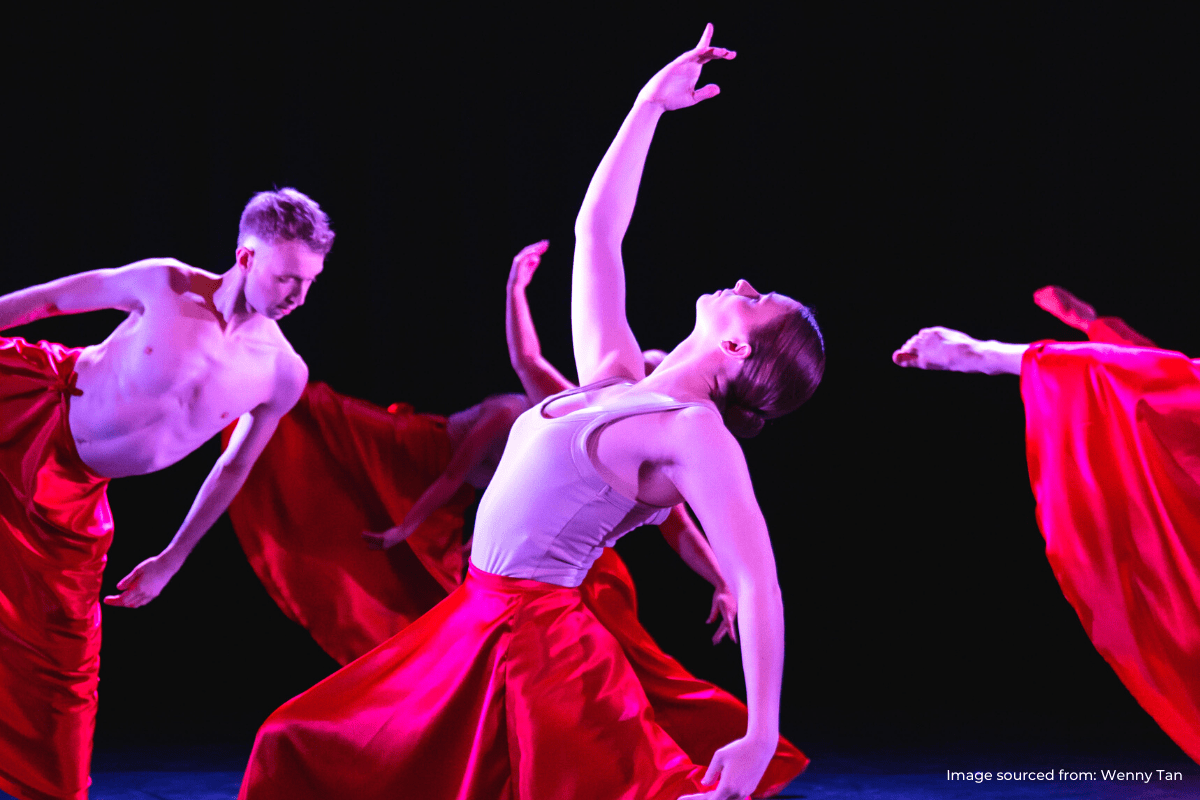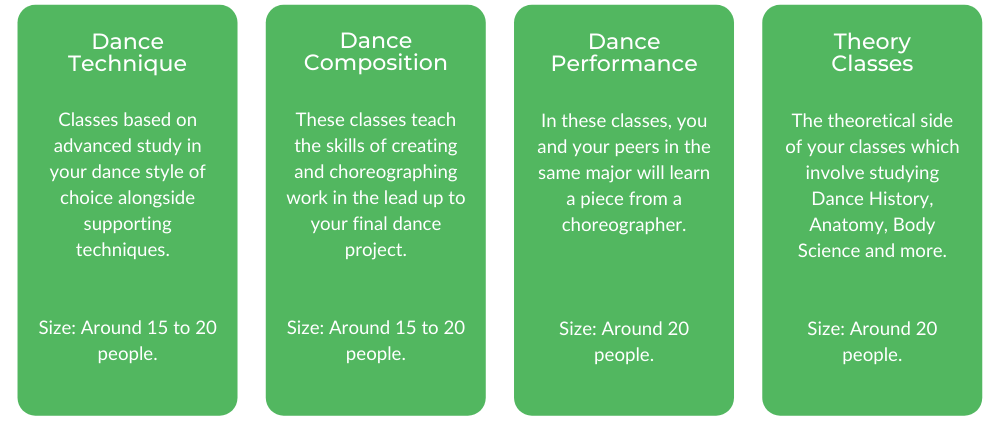Are you passionate about dance and want to take it on as a profession? If you’ve been thinking about studying a Bachelor of Dance at the Academy of Music and Performing Arts (AMPA), we’ll help you figure out if it’s the right fit for you.
We’ll give you the run-down on everything you need to know about the degree, including the subjects, assessments, culture, faculty and more!
Let’s dive in!
What is a Bachelor of Dance at AMPA?
Core Units and Majors
How to Get into a Bachelor of Dance at AMPA
What’s the Teaching Format?
What’s the Faculty and Culture Like?
What is a Bachelor of Dance at AMPA?
A Bachelor of Dance at AMPA is a 2-year program that prepares students with the technical, theoretical, and creative skills to excel in the different facets of the performing arts industry. As a student, you will be partaking in regular performance opportunities and receive training by industry professionals to support you in your development as a highly skilled and versatile dance artist.
With a strong focus on practical work, AMPA is the only tertiary institute in NSW that offers a performance-based dance degree!
Who should study a Bachelor of Dance at AMPA?
This degree is well suited to students with an appreciation for dance who are passionate about performance and interested in channelling their creativity and composition abilities. If you’re training in Dance at school or at a private studio, a Dance degree may be just what you’re looking for!
Career Paths
A Bachelor of Dance at AMPA provides students with the opportunities to pursue performance, choreography, production or educational positions. For students interested in becoming a School Dance Teacher, you will need to obtain further postgraduate study in Dance Education/Teaching.
Some of the roles you might find yourself in include:
- Artistic Director
- Dance Artist
- Stage Manager
- Studio/School Teacher
- Arts Administrator
Core Units and Majors
What are the Core Units?
Alongside the classes contained in your major of choice, all students are required to participate in jazz, ballet and contemporary technique classes. These core technical classes are designed to ensure that students become well-rounded dancers who have knowledge of the different techniques.
Students are also required to complete complementary studies in theoretical classes such as Dance History and Appreciation, Body Science and Dance Production and are offered a range of electives every trimester.
Majors/Specialisations
A Bachelor of Dance at AMPA has three majors to choose from: Classical ballet, Contemporary and Jazz.
After your audition for AMPA, you will have a sit-down with the Head of Dance to discuss what style of dance you’re interested in and what kind of career that you’re looking to have. Don’t worry, you will still have the option to swap your major halfway through your degree if you’re looking to try a different style!
Image Credit: Wenny Tan
At the end of each trimester, you will have the opportunity to perform your newfound skills in a dance showcase!
Practical Placement
To foster connections in the dance industry and gain professional experience, students are required to complete an internship. The internship must be undertaken at a place that you haven’t worked before for 30 hours.
While students are expected to seek out opportunities independently, AMPA will assist in finding internships for students.
How to Get into a Bachelor of Dance at AMPA
To receive entry into a Bachelor of Dance at AMPA, the ATAR is not the main selection criteria.
Instead, students will need to demonstrate evidence of their talent and potential through a performance audition, interview and written task.
Assumed Knowledge and Prerequisite Subjects
There is no assumed knowledge or prerequisites for a Bachelor of Dance at AMPA apart from successful completion of the NSW Higher School Certificate or equivalent.
Pathway Programs
If you’ve completed a VET Diploma in Dance, the AMPA Pathways Program provides graduates with credit towards a Bachelor of Dance and enables students to receive up to 50% credit.
What scholarships are available?
AMPA has scholarships on offer for the Bachelor of Dance to support students who demonstrate outstanding ability and academic potential in dance.
What’s the Teaching Format?
A Bachelor of Dance at AMPA is delivered across three trimesters per year:
- Trimester 1: Late January to early May
- Trimester 2: Late May to late August
- Trimester 3: Early September to mid-December
Class Structure
You will have 4 different types of classes, which include Dance Technique, Dance Composition, Dance Performance and Theory Classes.
Dance Technique
Dance technique and performance classes are the most common classes, running for 1.5 hours and occurring multiple times a day. Most classes during your degree are based on advanced study in your dance style of choice alongside supporting techniques.
Dance Composition
Dance composition classes are based on learning the skills of creating and choreographing work in the lead up to your final dance project.
Your first four trimesters will focus on improvisation, solo and group composition and Composition A and B prepare students for their final choreography projects. Classes run for 1.5 hours and usually occur twice a week.
Dance Performance
Dance Performance classes are where you and your peers who are in your major learn a piece from a choreographer. These classes run for 1.5 hours and occur four times per week.
Theory Classes
Theory classes run for 1.5 hours and are dispersed throughout the week. Theory subjects include Dance History, Anatomy, Body Science, Musicianship, Lighting, Dance Film and more!
“There are around 15-20 people per class, so it’s a very small, intimate cohort. It’s good because the classes are big enough so you don’t feel like you’re doing your own thing, but it’s small enough that you can get enough attention from the teacher.” — Liam Berg
How much time do you spend on campus?
As a Dance student, you will have a very busy schedule consisting of 5 days of classes with an early 8:30am start and 3:30pm finish. However, students can go part-time if they require more flexibility.
The day generally consists of 2/3 of practical classes of technique and major, and then the remainder is dedicated to theory and project rehearsals.
What are the assessments like?
The assessment varies between classes, but most of your assessments will be practical based, particularly focusing on the technical skills of the style that you’ve been working on! You also have to complete written assessments, usually two per subject for each trimester.
Dance technique essays are usually focused on corrections given during classes or a question relating to a particular style.
For theory classes, essays are usually research-related, such as exploring typical injuries for Body Science. Assessments for theory subjects are also usually conducted in normal exam settings.
For your composition classes, you will have to create and perform your work in front of the class.
In your first four trimesters, you will work on creating a solo or a group piece. You will dedicate the last two trimesters to creating your final choreography project.
The first 12 weeks are spent on research and theory, in which you will create a giant report breaking down your project plan, mapping out its concept, inspiration, movement ideas and production elements!
“It’s a very time-consuming process, but at the end of it, you have something that you can present for grants, so it’s teaching you the skills to present your work in a way that isn’t just dancing. A lot of people who want to get into choreography don’t realise that it involves a lot of writing.” — Liam Berg
The last 12 weeks are spent on your creative process, in which you audition your peers and choreograph in collaboration with them to create a 15-minute piece to present at the end of the trimester.
“I interviewed several of my friends about their coming out experiences and each person in my cast represented a different interviewee. I’ve been dancing forever, and I’ve never really been in a piece that has told my friends’ stories and my own. As a ballet dancer, you’re always telling someone else’s story, and I had never really seen queer stories on stage. It was a great experience, and I got my best grades from that work.” — Liam Berg
What skills do you develop?
Throughout a Bachelor of Dance at AMPA, you will gain a good understanding of the base techniques to become a well-rounded dancer and a more knowledgeable teacher. Through your theory subjects, you will focus on learning how the body functions and how you can use it to the best of your ability.
Additionally, there are a variety of electives like acting, singing, acrobatics, pedagogy and contact improvisation that allow you to develop your skills in different areas of the performance industry.
What’s the Faculty and Culture Like?
Faculty
At AMPA, you will be guided through your dance journey by a broad range of dancers who have high levels of experience and qualifications in the industry. The faculty is known to be highly supportive of their students and many of the teachers have worked alongside notable artists and production companies.
Some of AMPA’s faculty members have ended up hiring AMPA’s students to work in their productions, projects or schools!
Culture
As a Dance student at AMPA, you can expect to have a jam-packed schedule that won’t leave you with much room for parties! There is a close-knit culture for Dance students and most students collaborate on professional work and have stayed in touch outside of university.
“There is a nice broad range of people wanting to learn a whole bunch of dance styles, which I think is really good.
I’ve spent a lot of time in professional ballet schools, and everyone doing the same thing can be quite intense, but I think going to AMPA was good because there was a diverse range of dance styles. It gives you a broader perspective of how different styles can come together and create something exciting.” — Liam Berg
Ashley Sullivan is a Content Writer for Art of Smart Education and is currently undertaking a double degree in Communications (Journalism) and a Bachelor of Laws at UTS. Ashley’s articles have been published in The Comma and Central News. She is a film, fashion and fiction enthusiast who enjoys learning about philosophy, psychology and unsolved mysteries in her spare time.






